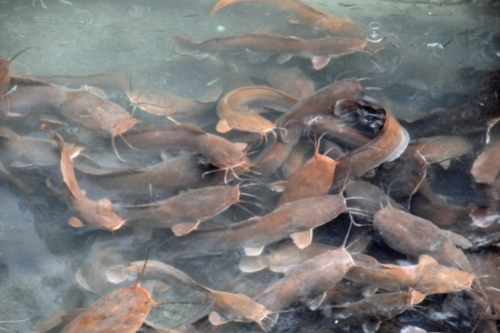Catfish are one of the fish that spawn in late spring or early summer. Flathead catfish will spawn when the temperature of the water hits between 66 and 75 degrees Fahrenheit. In contrast, channel and blue catfish will spawn when the water temperature reaches between 70 and 84 degrees Fahrenheit.
The female catfish will lay its eggs in the den at this period, leaving the male to protect and defend the eggs. The female will then go off to sleep and begin the healing process, while the male will protect the place for a few weeks without eating.
Many catfish fishermen feel that if the spawn is in action, they should either take a few weeks to break from fishing until things settle down, or they should completely shift gears and fish around the caves and dens where this fish spawn.
The goal is to locate the fish close to the den and attract them. That could be a total success or, in the worst case, a failure.
Some scientists agree that not all catfish spawn at the same period and that not all these fish spawn each year. It is essential to consider pre-spawn and determine if conditions are favorable for fish spawning. What you’ll discover is that pre-spawn catfish will continue to be caught in more aggressive areas, such as river current breaks.
You will observe that you will shift from catching strong pre-spawn catfish to capturing slender post-spawn catfish during this season. If the weather remains constant, the overall process would only take 2 to 3 weeks. That way you won’t have to wait too long.
Table of Contents
Where Do Catfish Spawn?
Consider the spaces beneath and between rocks or the heaps of garbage left by woods. Some catfish would even pick human-made structures such as buried automobile bodies, old tires, metal drums, etc. Tunnels or caves in clay banks, crevices, undercut banks, and hollow logs are all attractive for these fish.
Catfish will move into tributaries throughout the spawning season because they warm up even faster than the bigger body of water. The mouths of tributaries are important because it serves as a staging ground for spawning catfish.
If you stay slightly upstream of these spots, you might be able to fish some of the catfish that are hiding behind shelters that create gaps in the current, ready to surprise prey of their own.
Another good place to look would be downstream of dams built on huge rivers. Catfish will use the dam sites as a highly convenient solution if their typical spawning migratory paths are restricted.
Catfishing During the Spawn
Baitcasting is a standard method of catching catfish. You’ll require a free or spinning reel for this technique, which you’ll mount on the upper side of the catfish fishing rod. Baitcasting needs larger baits that can be cast further.
Ensure your rod has a fair amount of spring motion and also that it has an anti-kick reel and uses a 10-15 pound test line.
You could employ lures; however, if you really want to utilize live bait, chopped fish, shrimp, squid, and either soft or peeler crab are favorites of most catfish.
It is essential to know that fishing from shore, a pier, a bridge, or a boat at anchor is possible during most periods and hours of the day. You’ll be fishing near the bottom of the pond, where the fish are looking for food.
Specialists place riprap along dams, bridges, and causeways to prevent banks from collapsing. Since catfish prefer to spawn in the crevices between the stones, these banks create excellent fishing spots during the catfish spawn. The best spots aren’t always where the riprap is beautifully laid out.
The Post Catfish Spawn
It’s when the spawning period concludes and the fish recover before moving into the summer phase, where they’ll spend the remainder of the summer season until the waters calm down in the fall.
When the catfish have finished spawning, they must go into overdrive, feeding to recover from the lengthy period of time without food during the spawn. Imagine that a 10 lb catfish needs around a half-pound of food every day if it hasn’t eaten in 10 days.
That suggests this fish is approximately six pounds underweight. This, combined with the spawn’s increased energy needs. The fish must eat not simply to survive but also to regain all of their lost weight.
Everything in the feeding and metabolic process is dictated by the temperature of the water. If the water temp remains consistent, the catfish will go on a feeding frenzy to regain their weight very quickly and finally settle in the general location where they will spend the rest of the summer.

